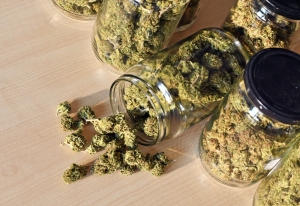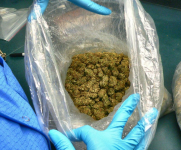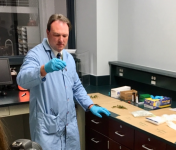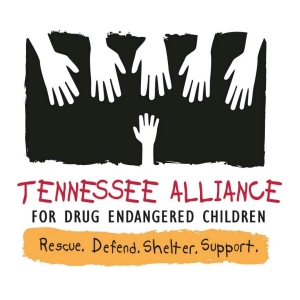Hemp & Marijuana
The Issue

Cannabis sativa has been cultivated for both its psychoactive properties (marijuana) and as a source of fiber (hemp). Both cultivars, marijuana and hemp, are the same plant - Cannabis sativa. Tennessee has legalized the cultivation of hemp and defined hemp as Cannabis sativa containing less than 0.3% THC. Marijuana, Cannabis sativa containing greater than 0.3% THC, is still illegal in Tennessee.
TBI, and other crime labs, have historically performed plant material testing by microscopically looking for unique botanical characteristics and performing a color test for compounds exclusive to Cannabis sativa. This historic testing is relatively quick and inexpensive.
Differentiating between hemp and marijuana is a topic of great interest for crime labs on a national scale. It is influenced not only by federal law, but by the laws of each individual state.
Reports and Publications
Laboratory Statistics
Below you will find the number of times each year the statewide TBI Crime Laboratory Forensic Chemistry Unit (FCU)
identified plant material as marijuana. While the numbers have been down in recent years, it is important to note that it may be the result of a policy change that requires our FCU scientists to maximize laboratory case outputs by
prioritizing cases with the highest penalty phases. Reductions in the number of marijuana reports may also be associated with a decrease in submissions related to widespread confusion surrounding the differences between hemp and marijuana.
| 2005 | 10,505 |
| 2006 | 11,632 |
| 2007 | 11,885 |
| 2008 | 10,605 |
| 2009 | 10,274 |
| 2010 | 9,477 |
| 2011 | 8,655 |
| 2012 | 9,458 |
| 2013 | 10,090 |
| 2014 | 8,622 |
| 2015 | 8,798 |
| 2016 | 9,241 |
| 2017 | 9,414 |
| 2018 | 10,652 |
| 2019 | 9,795 |
| 2020 | 7,051 |
| 2021 | 4,592 |
| 2022 | 4,354 |
| 2023 | 4,914 |
| 2024 | 4,800 |
Below you will find the number of times each year the TBI Crime Laboratory Forensic Chemistry Unit (FCU) identified THC. THC is typically identified in samples that are not plant material, such as food stuffs, vape cartridges, oils, etc. THC identification has increased dramatically in recent years.
| 2005 | 16 |
| 2006 | 39 |
| 2007 | 35 |
| 2008 | 36 |
| 2009 | 51 |
| 2010 | 51 |
| 2011 | 99 |
| 2012 | 107 |
| 2013 | 160 |
| 2014 | 196 |
| 2015 | 318 |
| 2016 | 340 |
| 2017 | 364 |
| 2018 | 497 |
| 2019 | 680 |
| 2020 | 594 |
| Delta 9 |
| 2021 | 615 | |
| 2022 | 417 | |
| 2023 | 492 | |
| 2024 | 472 |
TBI is aware of other cannabanoids that may be produced synthetically, derived from hemp, or derived from marijuana. We strive to provide appropriate testing as needed by the law enforcement community.
Resources
CLICK HERE for info on TADEC
CLICK HERE for info on the substance misuse hotline
Campaigns and Visuals
TBI's Testing Process
The Tennessee Bureau of Investigation uses a three-step protocol for submissions of plant material.
Presumptive Testing
In addition to traditional microscopic analysis and color test, TBI performs a second color test to estimate the THC-to-CBD ratio. Marijuana has a high ratio of THC to CBD (typically 9:1 or greater) and will turn the second color test blue. Hemp has a lower ratio of THC to CBD and will turn the second color test red.



Samples testing positive for the microscopic and both color tests are reported as: Cannabis – Visual and chemical color testing presumptively indicate the exhibit is marijuana.
Samples testing positive for the microscopic but negative for the new color test are reported as: Cannabis – Visual and chemical color testing presumptively indicate the exhibit is hemp.
Additional testing will only be performed at the District Attorney General’s request.
Comparative Testing
(Greater or Less than 1.0%)
Samples requiring further identification will be instrumentally analyzed along with a known, 1% THC control standard to estimate the THC concentration.
Frequently Asked Questions
CBD, or cannabidiol, is a chemical compound from the cannabis plant. Unlike tetrahydrocannabinol (THC), it's not psychoactive.
Delta-9 THC, or tetrahydrocannabinol, is the principal psychoactive chemical of the cannabis plant.
Tennessee has legalized the cultivation of hemp and defined hemp as Cannabis sativa containing less than 0.3% Delta-9 THC.
Marijuana, Cannabis sativa containing greater than 0.3% Delta-9 THC, is still illegal in Tennessee.
TBI currently uses a three-step testing protocol. TBI, like other crime labs, has historically performed plant material testing by microscopically looking for unique botanical characteristics and performing a color test for compounds exclusive to Cannabis sativa. This historic testing is relatively quick and inexpensive.
We perform a second color test to estimate the THC to CBD ratio. Marijuana has a high ratio of THC to CBD (typically 9:1 or greater) and will turn the second color test blue. Hemp has a lower ratio of THC to CBD and will turn the second color test red.
Hemp has a higher amount of CBD. Marijuana has a higher amount of Delta-9 THC. The color test used in TBI's crime laboratories indicates the difference between the two based upon that ratio, but does not indicate the actual percentages.
Testing to determine the quantitative THC percentage in plant material is both expensive and time-consuming, with regard to equipment and personnel. We are currently performing Delta-9 comparison testing when requested by District Attorney Generals. They are better suited to evaluate the circumstances and needs surrounding arrest and prosecution.
Yes. TBI currently tests misdemeanor amounts, and will continue to test Delta-9 THC at the request of the respective District Attorney General.
TBI is opposed to the legalization of marijuana in any form outside of the FDA and DEA approval process utilized for all other forms of medicine.

